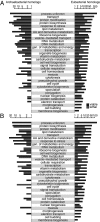Eukaryotic genes of archaebacterial origin are more important than the more numerous eubacterial genes, irrespective of function
- PMID: 20852068
- PMCID: PMC2951413
- DOI: 10.1073/pnas.1000265107
Eukaryotic genes of archaebacterial origin are more important than the more numerous eubacterial genes, irrespective of function
Abstract
The traditional tree of life shows eukaryotes as a distinct lineage of living things, but many studies have suggested that the first eukaryotic cells were chimeric, descended from both Eubacteria (through the mitochondrion) and Archaebacteria. Eukaryote nuclei thus contain genes of both eubacterial and archaebacterial origins, and these genes have different functions within eukaryotic cells. Here we report that archaebacterium-derived genes are significantly more likely to be essential to yeast viability, are more highly expressed, and are significantly more highly connected and more central in the yeast protein interaction network. These findings hold irrespective of whether the genes have an informational or operational function, so that many features of eukaryotic genes with prokaryotic homologs can be explained by their origin, rather than their function. Taken together, our results show that genes of archaebacterial origin are in some senses more important to yeast metabolism than genes of eubacterial origin. This importance reflects these genes' origin as the ancestral nuclear component of the eukaryotic genome.
Conflict of interest statement
The authors declare no conflict of interest.
Figures

Similar articles
-
Integration of two ancestral chaperone systems into one: the evolution of eukaryotic molecular chaperones in light of eukaryogenesis.Mol Biol Evol. 2014 Feb;31(2):410-8. doi: 10.1093/molbev/mst212. Epub 2013 Nov 4. Mol Biol Evol. 2014. PMID: 24188869 Free PMC article.
-
The neomuran origin of archaebacteria, the negibacterial root of the universal tree and bacterial megaclassification.Int J Syst Evol Microbiol. 2002 Jan;52(Pt 1):7-76. doi: 10.1099/00207713-52-1-7. Int J Syst Evol Microbiol. 2002. PMID: 11837318 Review.
-
Evolution of HSP70 gene and its implications regarding relationships between archaebacteria, eubacteria, and eukaryotes.J Mol Evol. 1993 Dec;37(6):573-82. doi: 10.1007/BF00182743. J Mol Evol. 1993. PMID: 8114110
-
A genome phylogeny for mitochondria among alpha-proteobacteria and a predominantly eubacterial ancestry of yeast nuclear genes.Mol Biol Evol. 2004 Sep;21(9):1643-60. doi: 10.1093/molbev/msh160. Epub 2004 May 21. Mol Biol Evol. 2004. PMID: 15155797
-
Comparative evaluation of gene expression in archaebacteria.Eur J Biochem. 1988 May 2;173(3):473-82. doi: 10.1111/j.1432-1033.1988.tb14023.x. Eur J Biochem. 1988. PMID: 3131139 Review.
Cited by
-
Endosymbiotic theories for eukaryote origin.Philos Trans R Soc Lond B Biol Sci. 2015 Sep 26;370(1678):20140330. doi: 10.1098/rstb.2014.0330. Philos Trans R Soc Lond B Biol Sci. 2015. PMID: 26323761 Free PMC article. Review.
-
An excavate root for the eukaryote tree of life.Sci Adv. 2023 Apr 28;9(17):eade4973. doi: 10.1126/sciadv.ade4973. Epub 2023 Apr 28. Sci Adv. 2023. PMID: 37115919 Free PMC article.
-
Origins and Functional Significance of Eukaryotic Protein Folds.J Mol Evol. 2023 Dec;91(6):854-864. doi: 10.1007/s00239-023-10136-x. Epub 2023 Dec 7. J Mol Evol. 2023. PMID: 38060007
-
Pan-genome analyses of model fungal species.Microb Genom. 2019 Feb;5(2):e000243. doi: 10.1099/mgen.0.000243. Epub 2019 Feb 4. Microb Genom. 2019. PMID: 30714895 Free PMC article.
-
A bioenergetic basis for membrane divergence in archaea and bacteria.PLoS Biol. 2014 Aug 12;12(8):e1001926. doi: 10.1371/journal.pbio.1001926. eCollection 2014 Aug. PLoS Biol. 2014. PMID: 25116890 Free PMC article.
References
Publication types
MeSH terms
LinkOut - more resources
Full Text Sources
Molecular Biology Databases

